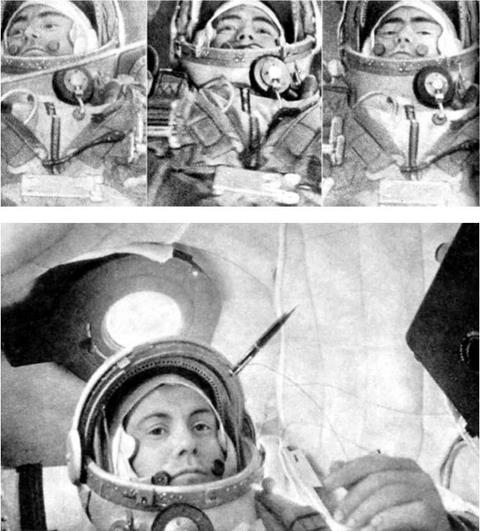VOSTOK 3 AND 4
 1962 alpha upsilon 1 (Vostok 3), alpha nu 1 (Vostok 4) 11 (Vostok 3) and 12 (Vostok 4) August 1962 Pad 1, Site 5, Baikonur Cosmodrome, Kazakhstan (both vehicles)
1962 alpha upsilon 1 (Vostok 3), alpha nu 1 (Vostok 4) 11 (Vostok 3) and 12 (Vostok 4) August 1962 Pad 1, Site 5, Baikonur Cosmodrome, Kazakhstan (both vehicles)
15 August 1962
South of Karaganda, Kazakhstan (Vostok 3), Vostok 4
landed a further 190 km away
R7 (8K72K); spacecraft serial number (11F63/3KA)
#5 (Vostok 3); and #6 (Vostok 4)
3 days 22hrs 22 min (Vostok 3); 2 days 22hrs 57 min (Vostok 4)
Sokol (Falcon) – Vostok 3; Berkut (Golden Eagle) – Vostok 4
Simultaneous extended-duration flight of two spacecraft
Flight Crew
NIKOLAYEV, Andrian Grigoryevich, 32, Soviet Air Force, pilot Vostok 3 POPOVICH, Pavel Romanovich, 31, Soviet Air Force, pilot Vostok 4
Flight Log
The dual flight of Vostok 3 and 4 resulted from a desire to demonstrate the ability to control two separate spacecraft in orbit at the same time (crucial to Soviet plans for multi-spacecraft exploration of the Moon and the creation of space stations) and to monitor the condition of two cosmonauts simultaneously during and after relatively long duration flights. This was not seen as the prime objective publicly, however, which was proved by the spectacular and ill-informed coverage of the missions in the western media in expectation of a space docking by the two spacecraft, and which only served to perpetuate the myth of a Soviet lead in space technology.
Vostok 3, with pilot Andrian Nikolayev, was launched at 13: 30 hrs Baikonur time on 11 August and was soon in a 64.93° orbit, with an apogee of 227 km (141 miles). The mission was described as a long-duration one by Soviet officials, who sprang a shock in the west at 13 : 02 hrs the following day by launching Vostok 4 crewed by Pavel Popovich, as Vostok 3 flew overhead. As Vostok 4 entered orbit, it passed to within 6.5 km (4 miles) of Vostok 3. The relatively close encounter was brief, and with no manoeuvring ability it was impossible to achieve a rendezvous in space. The western media, however, lapped it all up. The dual mission of “Nik and Pop”, as the cosmonauts were dubbed, was described as a rendezvous in space and the mission as a huge leap forward by the Soviets towards a manned landing on the Moon in a matter of years.
|
Nikolayev (Vostok 3, top) and Popovich (Vostok 4, bottom) shown inside their respective spacecraft during their historic “group flight”, demonstrating the wonders of microgravity. |
In their individual orbits – Vostok 4’s apogee was 234 km (146 miles), with a 64.98° inclination – Nikolayev and Popovich monitored their health and were allowed to undo their straps to float about freely in the rather spacious cockpit. This was not merely a luxury, but an experiment to see whether the unrestrained movement would bring about inner ear disturbance and cause nausea, which in the case of Nikolayev and Popovich it did not. They ate proper packaged food, such as cutlets, pies and fruit, and Nikolayev was the first cosmonaut to be featured on national TV programmes
from his cockpit. The official objectives of the two missions were to maintain radio contact with Earth; carry out regular psychological, physiological and vestibular tests; orientate the spacecraft using attitude control thrusters; make observations using binoculars and the naked eye; float free during the fourth and each second orbit for a period of between 50 to 60 minutes at a time; regulate cabin atmosphere; conduct biological experiments; take food four times a day; and record in a log book and tape recorder their observations and progress of the flight plan.
The missions were eagerly used by Premier Nikita Khrushchev for propaganda purposes, hammering home the Soviet lead over the USA. By the end of the Vostok 3 mission, after 64 orbits, Vostok 4 had drifted 2,720 km (1,690 miles) away. Nikolayev landed south of the town of Karaganda at T + 3 days 22 hours 22 minutes on 15 August, and the same day, Popovich landed 190 km (118 miles) away at T + 2 days 22 hours 57 minutes. Neither had succumbed to space sickness and this led to the conclusion that the affliction was experienced by only some space travellers and not all who made long journeys. Even longer Vostok missions were then planned.
Milestones
7th and 8th manned space flights 3rd and 4th Soviet manned space flights 3rd and 4th Vostok manned flights 1st joint manned space flight 1st in-flight public TV











